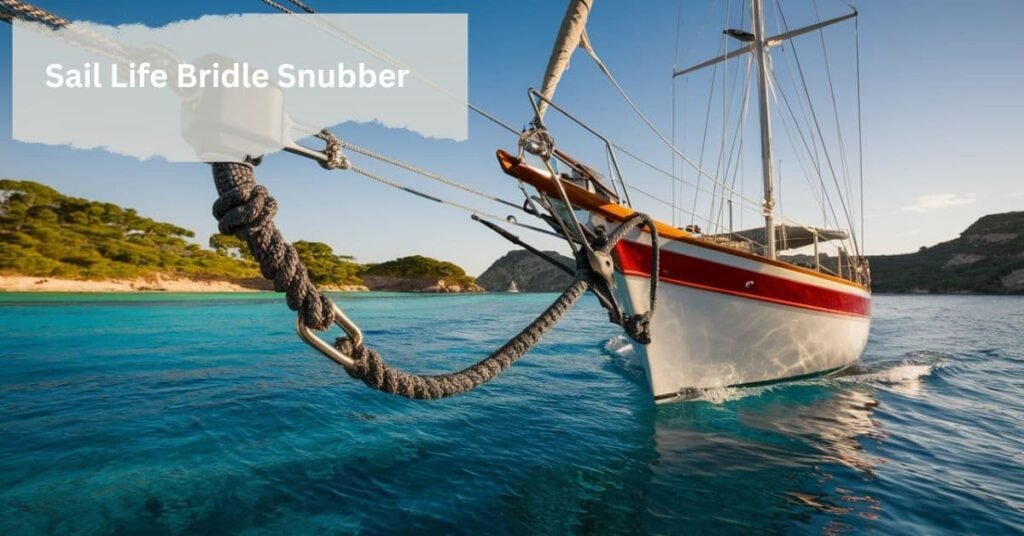
When sailing, ensuring your vessel’s safety and performance is a top priority. One of the essential pieces of equipment that can improve your vessel’s performance in various weather conditions is the Sail Life Bridle Snubber. This simple yet effective tool can make all the difference when it comes to handling your boat, especially when anchored in rough waters or when you’re on a long voyage. In this guide, we’ll explore what a bridle snubber is, how it works, why it’s important, and how to choose the right Sail Life Bridle Snubber for your needs.
What is a Sail Life Bridle Snubber?
A Sail Life Bridle Snubber is a piece of equipment that is typically used to reduce the stress on your boat’s anchoring system when anchored or moored in turbulent waters. This simple device serves as a shock absorber for the anchor rode (the rope or chain that connects your boat to the anchor). By distributing the load more evenly across the anchor and preventing the chain or rope from slapping against the boat, it helps reduce strain on your anchor, anchor chain, and boat’s cleats.
The bridle snubber usually consists of a strong rope with a snubber hook, which is connected to two points on the boat’s bow. This helps to distribute the force between two lines, making it easier to control and reducing the strain on any one part of the system.
Why is a Sail Life Bridle Snubber Important?
Anchoring your boat securely is crucial, especially when dealing with challenging weather conditions, such as storms, strong winds, or heavy swells. The Sail Life Bridle Snubber plays a key role in improving the stability and safety of your boat by providing the following benefits:
1. Reducing Strain on Your Anchor System
One of the most significant benefits of using a Sail Life Bridle Snubber is its ability to reduce the strain on the anchor system. When a boat is anchored, especially in rough waters, the anchor chain or rope can become tight and experience shock loads. The snubber acts as a cushion, absorbing these shocks and preventing them from transferring to the boat’s anchoring system.
This helps protect not only your boat but also your anchor chain and winch from excessive wear and tear, which can be costly to repair or replace. The snubber absorbs much of the impact, ensuring that your boat remains anchored securely, no matter the conditions.
2. Enhancing Comfort on Board
Another benefit of using a Sail Life Bridle Snubber is improved comfort on board. When you’re anchored in rough seas, the constant motion of the boat can be tiring and uncomfortable, especially when the chain or rode jerks and slaps against the boat. The bridle snubber significantly reduces the noise and movement caused by this by absorbing the force before it reaches the boat, making your stay on board more peaceful.
3. Preventing Damage to the Boat
Using a bridle snubber also helps prevent damage to the boat. Without it, the constant jerking of the anchor line can cause chafing and abrasion, which can wear away the surface of the boat, especially around the bow. Over time, this can lead to costly repairs. The Sail Life Bridle Snubber acts as a protective layer, preventing direct contact between the anchor rode and the boat, thus reducing the risk of damage.
4. Allowing More Control Over Your Boat
With the Sail Life Bridle Snubber, you can maintain better control over your boat while anchored. It offers the ability to fine-tune the tension of the lines, helping the boat stay more stable in rough conditions. The snubber’s ability to absorb shock ensures that your boat remains more stable, which makes handling easier and less stressful, especially in adverse weather.
Types of Sail Life Bridle Snubbers
Not all Sail Life Bridle Snubbers are created equal. There are different types of snubbers available, each designed for different applications and boat types. Understanding the different types of snubbers will help you select the one that best fits your needs.
1. Elastic Bridle Snubber
The elastic bridle snubber is the most common type. It’s designed to stretch and absorb shocks more efficiently by utilizing a rubber or elastic material. This snubber is ideal for most recreational boats, as it provides a great balance of shock absorption and durability. The elastic nature of the snubber allows it to stretch with the motion of the boat and then return to its original shape when the stress is released.

2. Non-Elastic Bridle Snubber
For heavier boats, especially those used in commercial or long-distance cruising, a non-elastic bridle snubber may be more suitable. This type of snubber is made of a non-stretchable material like nylon or polyester, which provides a more rigid connection between the boat and the anchor system. While it doesn’t absorb shock as well as an elastic version, it is much more durable and can withstand higher loads.
3. Combination Bridle Snubber
A combination bridle snubber uses both elastic and non-elastic materials, offering a balanced approach. The elastic material handles shock absorption, while the non-elastic portion helps distribute the load evenly. This type of snubber is ideal for boats that experience varying conditions and require a versatile solution.
4. Custom-Fit Snubber
Some sailors opt for custom-fit snubbers, which are made specifically for their boat and anchoring system. These snubbers offer the highest level of customization, allowing sailors to choose materials, length, and specific features that best suit their vessel’s needs. While custom snubbers tend to be more expensive, they can offer a higher level of performance and durability.
How to Choose the Right Sail Life Bridle Snubber
Choosing the right Sail Life Bridle Snubber is crucial to ensuring that it performs as expected and provides maximum benefit to your boat. Here are some key factors to consider when selecting a snubber:
1. Boat Size and Weight
The size and weight of your boat will influence the type of snubber you need. Smaller, lighter boats may only require an elastic bridle snubber, while larger, heavier vessels may need a non-elastic or combination snubber to handle the increased load.
2. Anchor Type and Line Length
The type of anchor and the length of your anchor line should also be taken into account. If you have a long anchor rode or chain, you’ll need a snubber that can handle the additional tension. For shorter rode lengths, a smaller snubber may suffice.
3. Material Durability
Durability is crucial for the snubber’s performance. Materials such as high-quality rubber, nylon, or polyester offer strong resistance to wear, UV damage, and saltwater corrosion. Always look for a snubber made from materials designed to withstand the harsh marine environment.
4. Ease of Use and Maintenance
A Sail Life Bridle Snubber should be easy to use and maintain. Look for models that come with simple instructions and are quick to set up and remove. Additionally, consider a snubber that can be cleaned and maintained without difficulty to ensure a long lifespan.
How to Install a Sail Life Bridle Snubber
Installing a Sail Life Bridle Snubber is a straightforward process. Here’s a step-by-step guide on how to properly install one:
Attach the Snubber to the Anchor Rode
Start by attaching the snubber to the anchor rode. The snubber will typically have a loop or hook at one end that you can use to connect to the rode. Ensure that the snubber is securely fastened to prevent it from coming loose during use.
Connect the Snubber to the Boat
Next, attach the other end of the snubber to the boat. This is usually done by securing the snubber’s hooks or loops to the cleats or other strong points on the boat’s bow. Make sure that the snubber is positioned so that it can evenly distribute the load between the two points.
Adjust the Tension
Once the snubber is in place, adjust the tension by tightening or loosening the lines. The goal is to ensure that the snubber can absorb shock without being too tight or too loose. Too much tension can prevent the snubber from absorbing shock effectively, while too little tension may result in it not functioning properly.
Monitor the System
After the snubber is in place, monitor the system to ensure that it is functioning as expected. If you notice any signs of wear or damage, replace the snubber immediately to avoid compromising your boat’s safety.
Maintenance and Care of Your Sail Life Bridle Snubber
Proper maintenance is essential to ensure that your Sail Life Bridle Snubber continues to function effectively over time. Here are some tips for caring for your snubber:
1. Inspect Regularly
Inspect your snubber regularly for signs of wear, tear, or damage. Check for fraying, cracking, or discoloration in the material, as these can be indicators that the snubber is no longer functioning properly.
2. Clean After Each Use
After each use, rinse the snubber with fresh water to remove any saltwater or debris that may have accumulated. This will help prevent corrosion and ensure that the snubber remains in good condition.
3. Store Properly
When not in use, store the snubber in a dry, cool place away from direct sunlight. UV rays can degrade the material over time, so proper storage is essential to extend the life of the snubber.
Conclusion
A Sail Life Bridle Snubber is an invaluable tool for sailors who want to protect their boat, anchor system, and maintain comfort while anchored. It helps reduce strain on your boat’s anchor system, improves stability, prevents damage, and ensures a more peaceful experience during long periods at anchor. By choosing the right type of snubber, installing it properly, and maintaining it regularly, you can enjoy safer, more enjoyable sailing experiences. Whether you’re an experienced sailor or a beginner, the Sail Life Bridle Snubber is an investment that will pay off in the long run.


